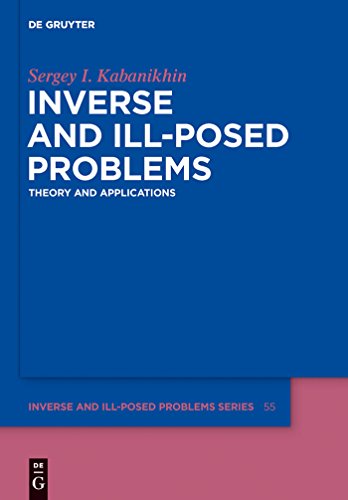Articoli correlati a Inverse and Ill-Posed Problems: Theory and Applications:...

The text demonstrates the methods for proving the existence (if at all) and finding of inverse and ill-posed problems solutions in linear algebra, integral and operator equations, integral geometry, spectral inverse problems, and inverse scattering problems. It is given comprehensive background material for linear ill-posed problems and for coefficient inverse problems for hyperbolic, parabolic, and elliptic equations. A lot of examples for inverse problems from physics, geophysics, biology, medicine, and other areas of application of mathematics are included.
Le informazioni nella sezione "Riassunto" possono far riferimento a edizioni diverse di questo titolo.
Sergey I. Kabanikhin, Sobolev Institute of Mathematics, Novosibirsk, Russia.
Le informazioni nella sezione "Su questo libro" possono far riferimento a edizioni diverse di questo titolo.
- EditoreDe Gruyter
- Data di pubblicazione2011
- ISBN 10 3110224003
- ISBN 13 9783110224009
- RilegaturaCopertina rigida
- Numero edizione1
- Numero di pagine459
Compra nuovo
Scopri di più su questo articolo
Spese di spedizione:
EUR 48,99
Da: Germania a: U.S.A.
I migliori risultati di ricerca su AbeBooks
Inverse and Ill-posed Problems
Print on DemandDescrizione libro Gebunden. Condizione: New. Dieser Artikel ist ein Print on Demand Artikel und wird nach Ihrer Bestellung fuer Sie gedruckt. Sergey I. Kabanikhin,. Codice articolo 4455402
Inverse and Ill-posed Problems
Descrizione libro Buch. Condizione: Neu. This item is printed on demand - it takes 3-4 days longer - Neuware -The theory of ill-posed problems originated in an unusual way. As a rule, a new concept is a subject in which its creator takes a keen interest. The concept of ill-posed problems was introduced by Hadamard with the comment that these problems are physically meaningless and not worthy of the attention of serious researchers. Despite Hadamard's pessimistic forecasts, however, his unloved 'child' has turned into a powerful theory whose results are used in many fields of pure and applied mathematics. What is the secret of its success The answer is clear. Ill-posed problems occur everywhere and it is unreasonable to ignore them. Unlike ill-posed problems, inverse problems have no strict mathematical definition. In general, they can be described as the task of recovering a part of the data of a corresponding direct (well-posed) problem from information about its solution. Inverse problems were first encountered in practice and are mostly ill-posed. The urgent need for their solution, especially in geological exploration and medical diagnostics, has given powerful impetus to the development of the theory of ill-posed problems. Nowadays, the terms 'inverse problem' and 'ill-posed problem' are inextricably linked to each other. Inverse and ill-posed problems are currently attracting great interest. A vast literature is devoted to these problems, making it necessary to systematize the accumulated material. This book is the first small step in that direction. We propose a classification of inverse problems according to the type of equation, unknowns and additional information. We consider specific problems from a single position and indicate relationships between them. The problems relate to different areas of mathematics, such as linear algebra, theory of integral equations, integral geometry, spectral theory and mathematical physics. We give examples of applied problems that can be studied using the techniques we describe. This book was conceived as a textbook on the foundations of the theory of inverse and ill-posed problems for university students. The author's intention was to explain this complex material in the most accessible way possible. The monograph is aimed primarily at those who are just beginning to get to grips with inverse and ill-posed problems but we hope that it will be useful to anyone who is interested in the subject. 476 pp. Englisch. Codice articolo 9783110224009
Inverse and Ill-posed Problems : Theory and Applications
Descrizione libro Buch. Condizione: Neu. Druck auf Anfrage Neuware - Printed after ordering - The theory of ill-posed problems originated in an unusual way. As a rule, a new concept is a subject in which its creator takes a keen interest. The concept of ill-posed problems was introduced by Hadamard with the comment that these problems are physically meaningless and not worthy of the attention of serious researchers. Despite Hadamard's pessimistic forecasts, however, his unloved 'child' has turned into a powerful theory whose results are used in many fields of pure and applied mathematics. What is the secret of its success The answer is clear. Ill-posed problems occur everywhere and it is unreasonable to ignore them. Unlike ill-posed problems, inverse problems have no strict mathematical definition. In general, they can be described as the task of recovering a part of the data of a corresponding direct (well-posed) problem from information about its solution. Inverse problems were first encountered in practice and are mostly ill-posed. The urgent need for their solution, especially in geological exploration and medical diagnostics, has given powerful impetus to the development of the theory of ill-posed problems. Nowadays, the terms 'inverse problem' and 'ill-posed problem' are inextricably linked to each other. Inverse and ill-posed problems are currently attracting great interest. A vast literature is devoted to these problems, making it necessary to systematize the accumulated material. This book is the first small step in that direction. We propose a classification of inverse problems according to the type of equation, unknowns and additional information. We consider specific problems from a single position and indicate relationships between them. The problems relate to different areas of mathematics, such as linear algebra, theory of integral equations, integral geometry, spectral theory and mathematical physics. We give examples of applied problems that can be studied using the techniques we describe. This book was conceived as a textbook on the foundations of the theory of inverse and ill-posed problems for university students. The author's intention was to explain this complex material in the most accessible way possible. The monograph is aimed primarily at those who are just beginning to get to grips with inverse and ill-posed problems but we hope that it will be useful to anyone who is interested in the subject. Codice articolo 9783110224009

